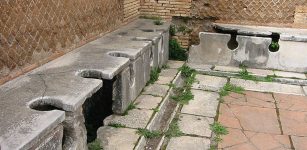Ostia Antica – Unique Ancient Harbor City In The Suburbs Of Rome
A. Sutherland - AncientPages.com - A few kilometers from Rome, there are ruins of the ancient city of Ostia ( Ostia (literally translated as "the mouth"), which by its historical importance and preservation is not inferior to Pompeii and Herculaneum, the two famous flourishing Roman towns engulfed by Vesuvius eruption on August 24, AD 79.
Today, Ostia (modern Ostia Antica) is the most significant archaeological site in the vicinity of Rome. It is believed that Ostia Antica may have been one of the very first Roman colonies.
According to an ancient legend, Ancus Marcius (642 to 617 BC), the semi-legendary fourth king of Rome, founded the port of Ostia at the mouth of the Tiber River.
There is an inscription that confirms the establishment of the old castrum of Ostia in the 7th century BC. The oldest archaeological remains so far discovered date back to only the 4th century BC and the most ancient buildings preserved until today, date back to the 3rd century BC.
Augustus who was a Roman statesman, military leader and the first Emperor of the Roman Empire, controlling Imperial Rome from 27 BC until his death in AD 14, contributed much to Ostia's importance.

Ruins of Ostia Antica. Source
The city was provided with a theater, a first forum, and an aqueduct. Important for the city was also the construction of the port of Claudius, and particularly that of the port of Trajan.
Both these constructions further increased Ostia's importance as an administrative center for trade. When Rome developed a navy, Ostia became a naval base, complete with a fort and served as the main fleet base on the west coast of Italy. By AD 150, when Rome controlled the entire Mediterranean region, Ostia was also a busy commercial port.
Originally the Tiber River flowed into the sea precisely at the spot where the Romans founded the ancient port city of Ostia in the 4th Century B.C. The name itself is derived from the Latin word “ostium” for – estuary.
By the 2nd century AD, it had become a flourishing commercial center inhabited by more than 100,000 people. Today, Ostia’s people are gone, but the ruined houses, mosaics on the floors, frescoes on the walls, paved roads, piazzas, empty taverns, and grocery shops are still intact.
Surprisingly well-preserved are also avenues and streets that give an idea of what life was like in an ancient commercial seaport during the height of the Roman Empire.
Among other structures, there are city’s public baths, a necropolis, many apartments where the poor dock workers lived, Christian chapels, docks, and warehouses.
See also:
Herculaneum Time Capsule: Ancient Scrolls With Secrets Buried Under Volcanic Ash And Stones
“Altar Of Twelve Gods” At Gabii, Italy Was Once An Important Ancient Place
Bizarre Ancient Lie Detector – The Mouth Of Truth – Bocca della Verità
There is also the well-preserved amphitheater, built in the AD 1st and 2nd centuries, with 2,700 seats. Several giant marble theater masks still survive on tufa columns at the stage.
Ostia Antica is preserved because of the sand and mud from the Tiber that covered the port after it had been abandoned when Rome fell in the 5th century AD.
With the end of the Roman Empire, Ostia fell slowly into decay and was finally abandoned in the 9th century due to several invasions and sackings. The remaining inhabitants moved to Gregoriopolis.
Later, the city was plundered for their marble to build the cathedrals in Orvieto, Florence and Pisa, Florence, and Orvieto.
During partial excavations, archaeologists unearthed remains of several temples dedicated to the Roman gods, a synagogue, a Christian basilica and many temples dedicated to the Persian god Mithras.
Ostia’s small museum features many interesting statues representing different religions of foreign countries. We must not forget that the Roman Empire’s busy seaport accommodated people practicing different religions from all over the world.
Written by – A. Sutherland - AncientPages.com Senior Staff Writer
Copyright © AncientPages.com All rights reserved. This material may not be published, broadcast, rewritten or redistributed in whole or part without the express written permission of AncientPages.com
Expand for referencesReferences:
More From Ancient Pages
-
 2,000-Year-Old Roman Road Discovered In Cluj-Napoca, Romania
Archaeology | Jan 23, 2023
2,000-Year-Old Roman Road Discovered In Cluj-Napoca, Romania
Archaeology | Jan 23, 2023 -
 Cleveland’s Prehistoric Sea Monster Had A Mouth Twice As Large As A Great White Shark
Fossils | Mar 3, 2023
Cleveland’s Prehistoric Sea Monster Had A Mouth Twice As Large As A Great White Shark
Fossils | Mar 3, 2023 -
 Ancient Romans Invented The First Bound Book
Ancient History Facts | Sep 25, 2017
Ancient Romans Invented The First Bound Book
Ancient History Facts | Sep 25, 2017 -
 New Chemical Reactions To Generate Building Blocks Of Proteins And DNA – Discovered
DNA | Jul 29, 2022
New Chemical Reactions To Generate Building Blocks Of Proteins And DNA – Discovered
DNA | Jul 29, 2022 -
 Secrets Of The Cathars – Mysterious Manuscript Of Jesus And His Pre-Flood Language
Featured Stories | Jan 18, 2019
Secrets Of The Cathars – Mysterious Manuscript Of Jesus And His Pre-Flood Language
Featured Stories | Jan 18, 2019 -
 Oldest Cyrillic Inscriptions Dated To The Time Of King Simeon the Great – Discovered
Archaeology | May 3, 2023
Oldest Cyrillic Inscriptions Dated To The Time Of King Simeon the Great – Discovered
Archaeology | May 3, 2023 -
 The Romans Spread Parasites – Their Hygienic Innovations Gave No Health Benefit
Archaeology | Jan 9, 2016
The Romans Spread Parasites – Their Hygienic Innovations Gave No Health Benefit
Archaeology | Jan 9, 2016 -
 Achilles – Son Of King Peleus And Leader Of The Nereids
Featured Stories | Sep 3, 2015
Achilles – Son Of King Peleus And Leader Of The Nereids
Featured Stories | Sep 3, 2015 -
 Vodyanoi: Evil Water Spirit In Ancient Beliefs Of The Slavs
Featured Stories | May 23, 2019
Vodyanoi: Evil Water Spirit In Ancient Beliefs Of The Slavs
Featured Stories | May 23, 2019 -
 Early Christian Necropolis Unearthed In Sant’Appianu Cathedral In Sagone, Corsica
Archaeology | Aug 3, 2020
Early Christian Necropolis Unearthed In Sant’Appianu Cathedral In Sagone, Corsica
Archaeology | Aug 3, 2020 -
 Kokopelli – Popular Trickster God Of The American Southwest Brought Happiness To People
Featured Stories | May 11, 2020
Kokopelli – Popular Trickster God Of The American Southwest Brought Happiness To People
Featured Stories | May 11, 2020 -
 Pharaoh Ramses II’s Sarcophagus On Display For The First Time In 50 Years
Artifacts | Apr 11, 2023
Pharaoh Ramses II’s Sarcophagus On Display For The First Time In 50 Years
Artifacts | Apr 11, 2023 -
 65,000-Year-Old ‘Stone Swiss Army Knives’ Show Early Humans Had Long-Distance Social Networks
Archaeology | Oct 22, 2022
65,000-Year-Old ‘Stone Swiss Army Knives’ Show Early Humans Had Long-Distance Social Networks
Archaeology | Oct 22, 2022 -
 How Important Was Music In Ancient Egypt?
Ancient History Facts | Jan 16, 2021
How Important Was Music In Ancient Egypt?
Ancient History Facts | Jan 16, 2021 -
 Rare, Well-Preserved Medieval Bone Flute Found In Kent
Archaeology | Nov 24, 2022
Rare, Well-Preserved Medieval Bone Flute Found In Kent
Archaeology | Nov 24, 2022 -
 Coca-Cola Was Invented As A Cure For Headache And Hangover In The 1880s
Ancient History Facts | Oct 23, 2017
Coca-Cola Was Invented As A Cure For Headache And Hangover In The 1880s
Ancient History Facts | Oct 23, 2017 -
 Traces Of Ancient Maya In Europe? Controversial Theory Examined
Ancient Mysteries | May 25, 2018
Traces Of Ancient Maya In Europe? Controversial Theory Examined
Ancient Mysteries | May 25, 2018 -
 Fascinating Altamura Man – One Of The Most Complete Neanderthal Skeletons Ever Discovered
Featured Stories | Jul 15, 2022
Fascinating Altamura Man – One Of The Most Complete Neanderthal Skeletons Ever Discovered
Featured Stories | Jul 15, 2022 -
 Early Māori Settlement On The Subantarctic Islands -Uncovering Some Of The Unknown
Archaeology | Jul 20, 2023
Early Māori Settlement On The Subantarctic Islands -Uncovering Some Of The Unknown
Archaeology | Jul 20, 2023 -
 Unusual Grave Of The Trzciniec Culture Is An Archaeological Puzzle
Archaeology | Dec 23, 2019
Unusual Grave Of The Trzciniec Culture Is An Archaeological Puzzle
Archaeology | Dec 23, 2019



